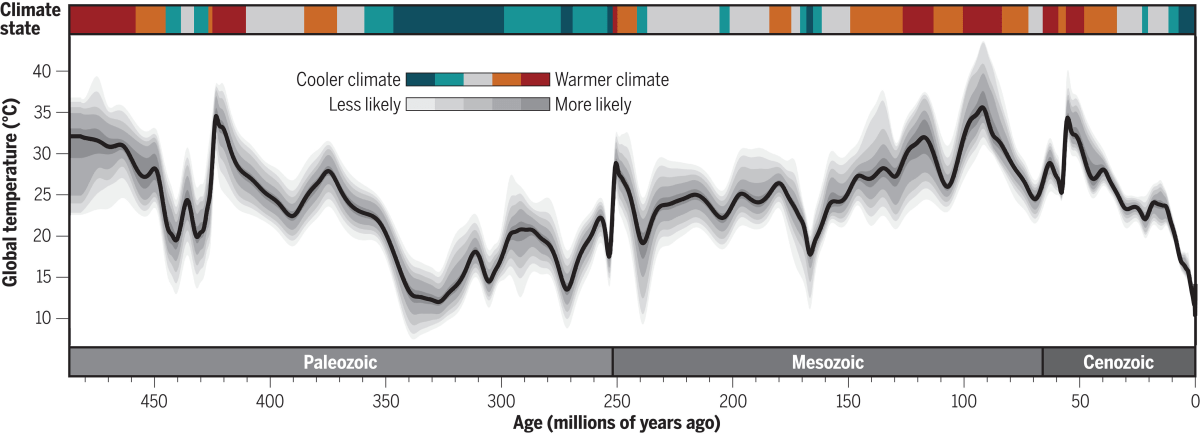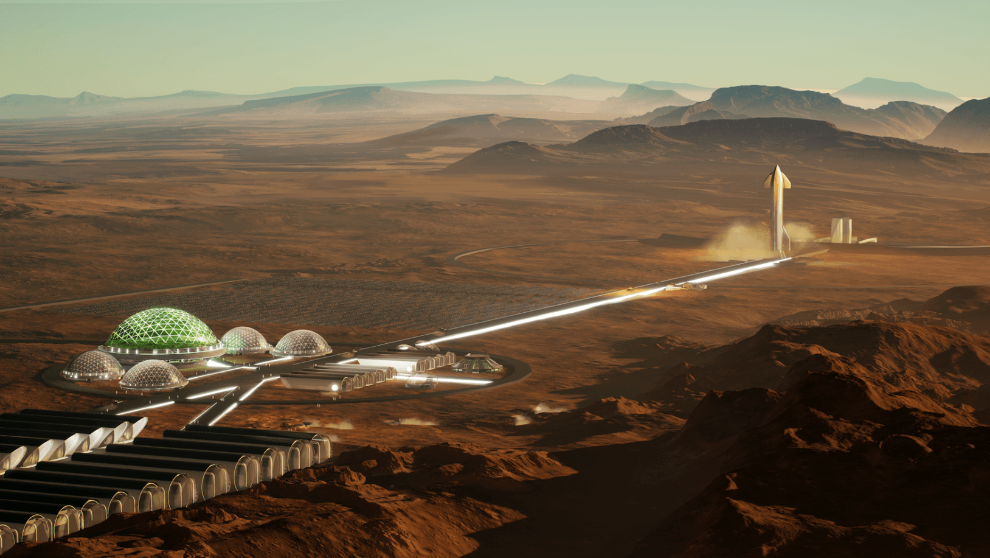*
Earth’s last half-billion years were action-packed. During that time, the climate underwent many changes. There have been changes in ocean levels and ice sheets, changes in the atmosphere’s composition, changes in ocean chemistry, and ongoing biological evolution punctuated with extinction events.
A record of Earth’s temperature over the last 485 million years is helping scientists understand how it all played out and illustrating what could happen if we continue to enrich the atmosphere with carbon.
The new temperature record is presented in research titled “A 485-million-year history of Earth’s surface temperature.” It’s published in Science, and the lead author is Emily Judd. Judd is from the Department of Paleobiology at the Smithsonian National Museum of Natural History.
“This research illustrates clearly that carbon dioxide is the dominant control on global temperatures across geological time.”
Jessica Tierney, University of Arizona
The new historical temperature comes from an effort named PhanDA, which stands for Phanerozoic Data Assimilation. PhanDA combined data from climate models with data from geology to determine how the climate has changed over the last nearly 500 million years. The Phanerozoic is Earth’s current geological eon, and it started 538.8 million years ago. It’s known for the proliferation of life, and its beginning is marked by the appearance of the hard shells of animals in the fossil record.
PhanDA is a mix of data and prior simulations by the scientific community. “This approach leverages the strengths of both proxies and models as sources of information, providing an innovative way to explore the temporal and spatial patterns in Earth’s climate across the Phanerozoic,” the researchers write in their paper. It allowed the researchers to reconstruct the climate more thoroughly.

“This method was originally developed for weather forecasting,” said Judd. “Instead of using it to forecast future weather, here we’re using it to hindcast ancient climates.”
We’re blowing by atmospheric carbon benchmarks, and the Earth is warming. We’re now at over 420 ppm of CO2. The best way to understand what’s coming our way is by looking at the past.
“If you’re studying the past couple of million years, you won’t find anything that looks like what we expect in 2100 or 2500,” said co-author Scott Wing, the curator of paleobotany at the National Museum of Natural History. Wing’s research focuses on the Paleocene–Eocene Thermal Maximum, a period of dramatic global warming 55 million years ago. “You need to go back even further to periods when the Earth was really warm, because that’s the only way we’re going to get a better understanding of how the climate might change in the future.”
During the Paleocene-Eocene Thermal Maximum (PETM), a massive amount of carbon was emitted into the atmosphere and the oceans. The Earth’s temperature reacted swiftly, warming by between five and eight degrees Celsius in only a few thousand years. While a few thousand years might seem long compared to a human lifetime, it’s nearly instantaneous for the climate of an entire planet. It likely triggered the massive extinction of between 35% to 50% of benthic life. Fossils show that during this time, sub-tropical planets grew in the polar regions.
Many scientists think the PETM is the best analogue for what we’re facing today. No matter what we do with our emissions in the next several decades, much of the carbon humanity has released into the atmosphere since the Industrial Revolution will persist in the atmosphere for thousands of years.

PhanDA illustrates the unbreakable link between carbon and global warming. According to co-author Jessica Tierney, a paleoclimatologist at the University of Arizona, the link between the climate and carbon is undeniable. “This research illustrates clearly that carbon dioxide is the dominant control on global temperatures across geological time,” said Tierney. “When CO2 is low, the temperature is cold; when CO2 is high, the temperature is warm.”
While proof of the link between climate and carbon isn’t new, this long timeframe drives it home. “The consistency of this relationship is surprising because, on this timescale, we expect solar luminosity to influence climate,” the authors write. “We hypothesize that changes in planetary albedo and other greenhouse gases (e.g., methane) helped compensate for the increasing solar luminosity through time.”
Overall, Earth’s global mean surface temperature (GMST) ranged from 11° to 36°C during the Phanerozoic, a larger range than previously thought. It also shows that greenhouse climates were hotter than thought. The largest temperature swings were in the high latitudes, but tropical temperatures ranged from 22 C to 42 C. This goes against the idea that the tropics have a fixed upper limit and shows that life must have evolved to survive in those higher temperatures.
The research also shows that our current climate is actually cooler than the climate through most of the Phanerozoic. Technically, Earth is in an ice age right now, though the ice is receding and has been for thousands of years. Earth’s current GMST is 15 Celsius, lower than during most of the Phanerozoic.
But while that may sound comforting, it’s not. It’s the rate of change in the GMST that’s dangerous. Our GHG emissions are warming the planet faster than at any time during the Phanerozoic.
“Humans, and the species we share the planet with, are adapted to a cold climate,” Tierney said. “Rapidly putting us all into a warmer climate is a dangerous thing to do.”

While PhanDA is generally in agreement with previous climate reconstructions, it deviates in some ways. For example, cold climate periods don’t always coincide with glaciation and ice ages. Earth’s surface is ever-changing, and that can make some conclusions difficult to reach. “Many of the traditional glacial indicators can have nonglacial origins, complicating the interpretation of the rock record, and limited outcrop of older rocks and poor age control can make it difficult to discern between isolated alpine glaciers and widespread ice sheets,” the authors explain.
But that doesn’t take much away from PhanDA. It strengthens our understanding of climate and carbon.

Shockingly, the work suggests that Earth’s climate is even more sensitive to CO2 than some current models show.
“PhanDA GMST exhibits a strong relationship with atmospheric CO2 concentrations, demonstrating that CO2 has been the dominant force controlling global climate variations across the Phanerozoic,” the authors write in their conclusion.





No comments! Be the first commenter?